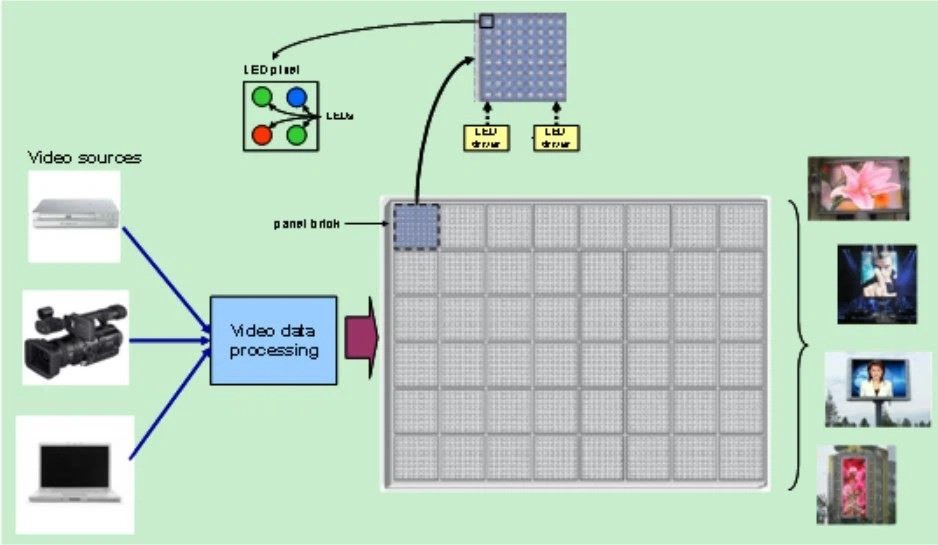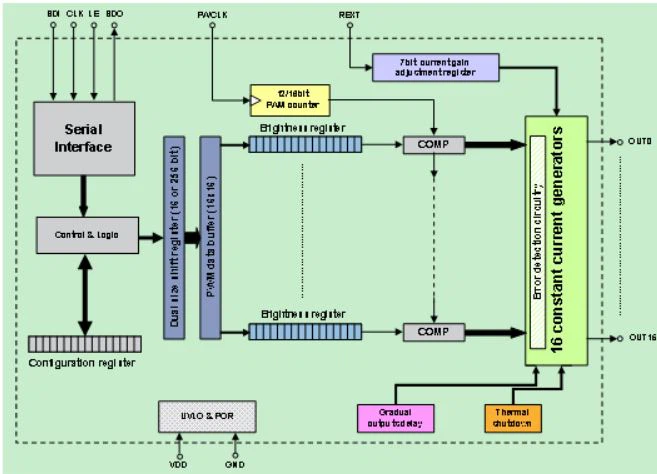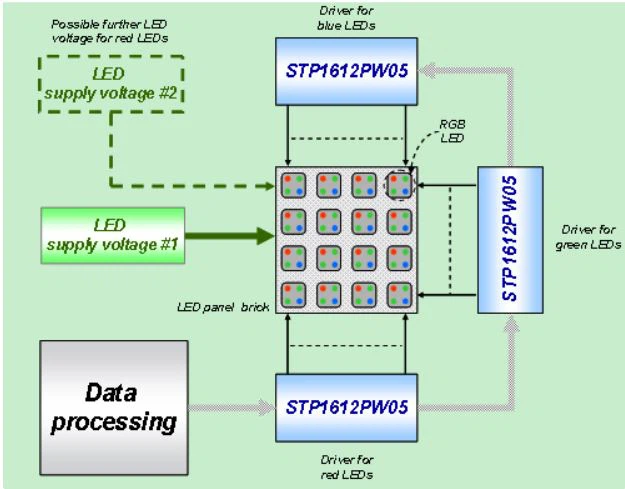LED Driver Solution for Full-color Video Display
Preface
The LED light-emitting diodes that we can see everywhere in our daily lives are no longer a new technology. The strong growth momentum of LEDs in multiple market segments is an established fact. Advertising display or digital signage is one of the most widely used areas of LED. From monochrome displays to full-color displays, LED solutions are widely used in road signs, advertising displays, indoor and outdoor video displays, etc. with different market needs and complexity. This article mainly discusses the main technical requirements of full-color LED video displays and how to achieve the required performance.
Full color LED video display
The full-color LED video display is a display that can display images and animations in millions of colors. LED display application scenarios include stadiums, building exteriors, shopping malls, and TV studios. Large LED displays are used to broadcast advertisements and information, replay sports events or concerts. Figure 1 is a simplified diagram of the LED display screen structure.
LED driver solution for full-color video display

Figure 1: Simplified diagram of LED full-color video display
The video input signals provided by different types of video sources are processed and sent to the LED display. The entire display screen is usually composed of a number of square or rectangular dot matrixes, and each dot matrix is composed of a number of pixels. Each pixel is composed of RGB (red, green, blue) LED tubes. By mixing the light colors of these LEDs, the required pixel information can be generated. The LED driver is equivalent to the interface between the processed video data and the colored lights emitted by the RGB LED (the image is composed of these colored lights).
Considering the target application of large-scale LED video display screens, it is easy for us to realize the important role played by picture quality. This concept includes several aspects:
-The signal quality and data processing capability of the original image is a prerequisite for good image quality.
-The size of the display screen, the resolution level, the pixel pitch and the LED selection are the key parameters that determine the image quality perceived by the human eye.
-Need to choose a suitable LED driver, which can convert the processed image data into the required color and animation effects.
Given that the purpose of this article is to describe the LED driver solutions for LED displays, we will focus on the last point of the three aspects mentioned above in the following chapters.
LED display requirements for LED drivers
In terms of color and animation, in order to achieve excellent image quality, it is necessary to integrate a variety of different functions: high frame rate, high refresh rate, color reproduction accuracy, etc. However, the quality of the display refers not only to the image itself, but also to the overall quality of the solution, such as anti-interference and reliability. Therefore, all color LED displays need to choose technically sophisticated LED drivers:
-Good color rendering depends on the effective brightness of each RGB (and each color): the higher the effective brightness, the richer the displayed colors. Reasonable and precise control of brightness requires the use of PWM dimming technology to control a large amount of brightness.
-High frame rate and high refresh rate require large amounts of data to be processed at a high rate. LED drivers can use high-frequency serial ports and flexible data format management functions to meet these requirements.
-The failure of one or more LED tubes will affect the accuracy of the pixel color, endanger the overall visual effect of the image, and affect the picture quality of the system. Maintaining the ideal visual effect of the display requires a reliable LED failure condition detection method.
Full color video display LED driver solution
STMicroelectronics has a variety of display and digital signage LED driver products. Among them, STP1612PW05 (see Figure 2) is an LED driver specially developed by STMicroelectronics for full-color LED video displays.
This product is a 16-channel LED driver with a built-in high-frequency serial data interface. The maximum output current of each channel is 60mA, and the output current can be adjusted by an external resistor, and 256-level gray scale can be accurately adjusted by using an 8-bit gain register. The improvement of current accuracy (typical value between channels ± 1.5%) at lower current meets the requirements for improving the luminous efficiency of LED technology. In fact, the advent of energy-efficient LEDs allows display manufacturers to use lower current LED drivers to achieve the same brightness.
The product is equipped with an independent adjustable PWM brightness control function for each output channel. The well-known advantages of PWM dimming function in LED color protection and 4096 (12-bit) or 65536 (16-bit) adjustable brightness can ultimately make color difference and image quality significantly improved.
In addition, in order to further enhance the dimming control function, the product also uses the Scrambled PWM mode. The total PWM cycle basically covers a lot of refresh cycles, the effect is like increasing the dimming frequency while keeping the dimming resolution unchanged, thereby reducing screen flicker.
The built-in serial interface of STP1612PW05 meets the high-speed data rate and data format flexibility requirements of the display screen: the data transmission clock frequency can be as high as 30MHz, and it adopts 16x16-bit format (if the brightness is 4096 levels, the data format is 6x12-bit) or higher compression 256-bit format.
As mentioned earlier, a robust and reliable LED driver can greatly improve the overall quality of the system. When a failed LED tube (open circuit or short circuit) is found, STP1612PW05 will send the detection result to the microcontroller through the serial interface, so as to avoid the color change or turn off of the relevant pixels, and to protect the consistency of the image.
LED driver solution for full-color video display

Figure 2: STP1612PW05 structure diagram
At the beginning of a frame of video image, all the LED tubes are turned on at the same time, which will generate an inrush current with a large rising slope, which means that a large input capacitance is required, the parasitic channel will oscillate, and the system will generate noise. Group the four continuous outputs into one group (the first group is OUT0, OUT1, OUT2, and OUT3; the second group is from OUT4 to OUT7; arranged in this order), with a continuous delay of 40ns between each group, so that the output channel is turned on The time is staggered so that the inrush current can be greatly reduced.
For any reason (the line is disconnected), the PWCLK clock signal does not exist (PWM counter clock signal, used for PWM dimming control), which will cause all LEDs on the display to be turned on indefinitely. In addition to affecting the correct display of the image, this kind of accident can also burn or damage the LED tube. STP1612PW05 has a built-in protection function that can activate the PWM clock timeout disconnection: when the PWCLK signal disappears for more than 1 second, the signal generator will be forcibly turned off.
Application Example
The LED forward voltage and the current that can be set to achieve the target brightness vary with the color of the LED: Among the three color LEDs of red, green and blue, the red LED has the lowest forward voltage, and the blue LED has the lowest drive current. . Therefore, it is recommended to use a different driver for each light color. Figure 3 describes an application example implemented with STP1612PW05.
LED driver solution for full-color video display

Figure 3: Design sketch of a full-color LED display dot matrix driven by STP1612PW05
Each display screen dot matrix is composed of 16 pixels, and each pixel is composed of 4 color LED tubes (1 red, 1 blue, and 2 green). 16 LEDs of the same color are driven by a STP1612PW05. The choice of LED supply voltage (VLED) is a balance between several often opposing requirements.
The VLED voltage should be high enough to enable the LED to maintain the correct on-state, but the voltage drop of the current generator of the LED driver should be minimized, otherwise it will cause useless power consumption and cause the chip and the system to overheat. Obviously, sharing the same VLED voltage for red, green and blue light is not the best solution. The ideal solution is to optimize the LED power supply voltage. Separating the voltage rails of the LED tubes can achieve the desired effect. This needs to drive all the LED tubes reasonably and save power at the same time.
In conclusion
The high-quality requirements of full-color LED video displays bring new challenges for designers to choose suitable LED drivers. Excellent color reproduction performance and minimized video distortion are basic requirements for these applications. ST's customized LED driver for full-color video displays is a high-quality solution that can meet the technical requirements of full-color video displays.



 售前客服
售前客服
